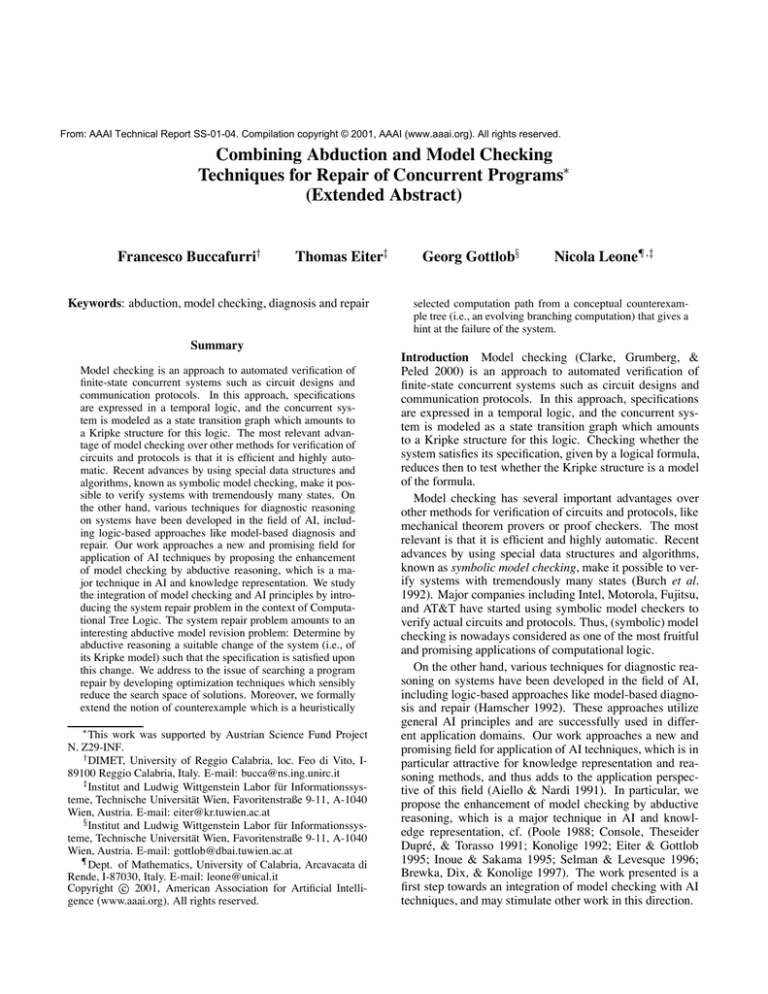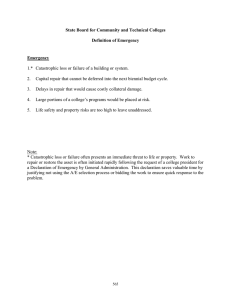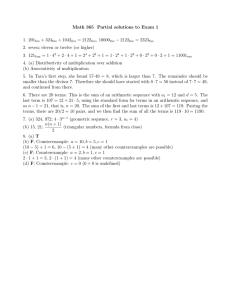
From: AAAI Technical Report SS-01-04. Compilation copyright © 2001, AAAI (www.aaai.org). All rights reserved.
Combining Abduction and Model Checking
Techniques for Repair of Concurrent Programs
(Extended Abstract)
Francesco Buccafurriy
Thomas Eiterz
Keywords: abduction, model checking, diagnosis and repair
Summary
Model checking is an approach to automated verification of
finite-state concurrent systems such as circuit designs and
communication protocols. In this approach, specifications
are expressed in a temporal logic, and the concurrent system is modeled as a state transition graph which amounts to
a Kripke structure for this logic. The most relevant advantage of model checking over other methods for verification of
circuits and protocols is that it is efficient and highly automatic. Recent advances by using special data structures and
algorithms, known as symbolic model checking, make it possible to verify systems with tremendously many states. On
the other hand, various techniques for diagnostic reasoning
on systems have been developed in the field of AI, including logic-based approaches like model-based diagnosis and
repair. Our work approaches a new and promising field for
application of AI techniques by proposing the enhancement
of model checking by abductive reasoning, which is a major technique in AI and knowledge representation. We study
the integration of model checking and AI principles by introducing the system repair problem in the context of Computational Tree Logic. The system repair problem amounts to an
interesting abductive model revision problem: Determine by
abductive reasoning a suitable change of the system (i.e., of
its Kripke model) such that the specification is satisfied upon
this change. We address to the issue of searching a program
repair by developing optimization techniques which sensibly
reduce the search space of solutions. Moreover, we formally
extend the notion of counterexample which is a heuristically
This work was supported by Austrian Science Fund Project
N. Z29-INF.
y DIMET, University of Reggio Calabria, loc. Feo di Vito, I89100 Reggio Calabria, Italy. E-mail: bucca@ns.ing.unirc.it
z Institut and Ludwig Wittgenstein Labor für Informationssysteme, Technische Universität Wien, Favoritenstraße 9-11, A-1040
Wien, Austria. E-mail: eiter@kr.tuwien.ac.at
x Institut and Ludwig Wittgenstein Labor für Informationssysteme, Technische Universität Wien, Favoritenstraße 9-11, A-1040
Wien, Austria. E-mail: gottlob@dbai.tuwien.ac.at
{
Dept. of Mathematics, University of Calabria, Arcavacata di
Rende, I-87030, Italy. E-mail: leone@unical.it
Copyright c 2001, American Association for Artificial Intelligence (www.aaai.org). All rights reserved.
Georg Gottlobx
Nicola Leone{ z
selected computation path from a conceptual counterexample tree (i.e., an evolving branching computation) that gives a
hint at the failure of the system.
Introduction Model checking (Clarke, Grumberg, &
Peled 2000) is an approach to automated verification of
finite-state concurrent systems such as circuit designs and
communication protocols. In this approach, specifications
are expressed in a temporal logic, and the concurrent system is modeled as a state transition graph which amounts
to a Kripke structure for this logic. Checking whether the
system satisfies its specification, given by a logical formula,
reduces then to test whether the Kripke structure is a model
of the formula.
Model checking has several important advantages over
other methods for verification of circuits and protocols, like
mechanical theorem provers or proof checkers. The most
relevant is that it is efficient and highly automatic. Recent
advances by using special data structures and algorithms,
known as symbolic model checking, make it possible to verify systems with tremendously many states (Burch et al.
1992). Major companies including Intel, Motorola, Fujitsu,
and AT&T have started using symbolic model checkers to
verify actual circuits and protocols. Thus, (symbolic) model
checking is nowadays considered as one of the most fruitful
and promising applications of computational logic.
On the other hand, various techniques for diagnostic reasoning on systems have been developed in the field of AI,
including logic-based approaches like model-based diagnosis and repair (Hamscher 1992). These approaches utilize
general AI principles and are successfully used in different application domains. Our work approaches a new and
promising field for application of AI techniques, which is in
particular attractive for knowledge representation and reasoning methods, and thus adds to the application perspective of this field (Aiello & Nardi 1991). In particular, we
propose the enhancement of model checking by abductive
reasoning, which is a major technique in AI and knowledge representation, cf. (Poole 1988; Console, Theseider
Dupré, & Torasso 1991; Konolige 1992; Eiter & Gottlob
1995; Inoue & Sakama 1995; Selman & Levesque 1996;
Brewka, Dix, & Konolige 1997). The work presented is a
first step towards an integration of model checking with AI
techniques, and may stimulate other work in this direction.
Main contributions The main contributions of our work,
which is described in more detail in (Buccafurri et al.
1999a), can be summarized as follows.
We study the integration of model checking and AI principles. In particular, we introduce the system repair problem in the context of Computational Tree Logic (CTL).
The latter is a propositional temporal logic which may be
used to express specifications of concurrent systems modeled as Kripke structures in this logic. The system repair
problem formalizes the repair of a concurrent system at
the semantical level. Notice that in a different context, repair was introduced in (Friedrich, Gottlob, & Nejdl 1990;
1994; Provan & Poole 1991).
The system repair problem amounts to an interesting abductive model revision problem: Determine by abductive reasoning a suitable change of the system (i.e., of its
Kripke model) such that the specification is satisfied upon
this change. Interestingly, this problem is an intermingled
abductive reasoning and theory revision problem, which
is best understood as an abductive theory revision problem. In fact, the system repair problem can be modeled as
an abductive theory revision problem in the frameworks
of (Lobo & Uzcátegui 1996; Inoue & Sakama 1995). Note
that the close relationship between abduction and revision
is well-recognized, and its investigation received increasing interest more recently, e.g., (Boutilier & Becher 1995;
Inoue & Sakama 1995; Lobo & Uzcátegui 1996; 1997).
We show that the proposed framework for system repair
can be profitably used, by providing an application to the
repair of concurrent programs and protocols. In particular, we describe a program repair problem, in which repair of a concurrent program in terms of changes at the
syntactical level (i.e., modifications of the program code)
is mapped to changes at the semantical level. As dealing with all possible modifications is clearly infeasible,
we restrict in our approach to some types of modifications which seem to be relevant in practice. A correction
is sequence = 1 q of single corrections i on the
program; it is a repair, if the modified program satisfies
the specification '. Applying AI principles and, in particular, Occam’s principle of parsimony, we provide also a
notion of minimal repair, which prunes repairs which are
not free of redundancy.
We address to the issue of searching a program repair.
In general, the search space for this problem is large. It
might still contain a high number of candidates, even if
only elementary corrections such as inverting the value of
an expression, or exchanging the name of a variable in a
Boolean assignment statement are allowed.
In order to tackle this problem, we develop optimization
techniques which sensibly reduce the search space for a
repair by exploiting structural information about the failure of the system provided by a counterexample. In particular, we formulate two pruning criteria referred to as
correction execution and correction exploitation, which
can be evaluated efficiently. In fact, given the program, a
collection of candidate repairs, and a counterexample, the
candidates violating these principles can be discarded in
linear time. As we demonstrate, this may yield considerable savings, and thus applying correction execution and
exploitation is an effective pruning method which comes
at low computational cost.
We formally extend the notion of counterexample from
(Clarke, Grumberg, & Long 1994), which is a heuristically selected computation path from a conceptual counterexample tree (i.e., an evolving branching computation)
that gives a hint at the failure of the system. As shown
by examples, there are cases in which no single path is a
counterexample. We therefore introduce the concept of a
multi-path, which enables representation of nested paths.
Multi-paths are a suitable tool for expressing full counterexample trees, which is needed for our purposes.
Technical development We provide the above results by
the following steps.
(1) First of all, we recall the syntax and semantics of
CTL. In addition to standard Boolean connectives, CTL has
linear-time and branching-time operators. The linear-time
operators are used to express statements involving the temporal order of events. The basic linear-time operators are
' (next time), ' (until), and ' (unless, releases);
further operators ' (always) and ' (eventually) are derived from them. The branching-time operators allow to take
the existence of multiple possible future scenarios into account, starting from a given point of a computation. That is,
the temporal order defines a tree which branches toward the
future. Thus, every point of time has a unique past, but, in
general, more than one future. Using the operators ' and
', one can express properties ' that are possible (true in
some computation branch, i.e., evolution of the system) and
necessary (true in every computation branch), respectively.
The semantics of CTL is formally defined using Kripke
structures. Informally, a Kripke structure consists of a finite
transition graph where each state is labeled with the atomic
propositions which are true in it.
(2) After these preliminary steps, we introduce the notion of a system repair problem, which provides a general
framework for the problem of properly changing a system at
the semantical level in order to meet a formal specification
in CTL. A system repair problem constitutes a kind of abductive model revision problem, which can be represented
in the frameworks for abductive theory change of (Lobo &
Uzcátegui 1996; Inoue & Sakama 1995).
(3) We then consider the corresponding problem at the
syntactical level, in particular the one of correcting concurrent programs and protocols. The program repair problem,
which is addressed there, resorts at the semantical level to a
system repair problem.
At this point, we focus on the problem of finding repairs.
In order to prune the search space, we try to exploit the information contained in counterexamples that witness the violation of the system specification.
For this purpose, we suitably generalize the notion of
counterexample in (Clarke, Grumberg, & Long 1994), and
show that counterexamples characterize errors. We model
counterexamples by multi-paths. Informally, a multi-path
represents an infinite tree T , by using a vertical axis rather
X
A
U
G
V
F
E
Process PA
Process PB
1: ag1A := true;
2: turn1B := false;
3: if ag1B and turn1B then
4:
goto 3;
5: x := x and y ;
6: ag1A := false;
7: if turn1B then
8: begin ag2A := true;
9:
turn2B := true;
10:
if ag2B and turn2B then
11:
goto 10;
12:
y := false;
13:
ag2A := false;
end ;
14: goto 1;
1: ag1B := true;
2: turn1B := false;
3: if ag1Anot
and
4:
goto 3;
5: x := x and y ;
6: ag2B := true;
7: turn2B := false;
8: if ag2Anot
and
9:
goto 8;
10: y := not y ;
11: x := x or y ;
12: ag2B := false;
13: ag1B := false;
14: goto 1;
turn1B then
turn2B then
Table 1: A concurrent program P and its specification '
than the usual recursion from a node to its descendants. The
branches of T are infinite paths; the axis is a distinguished
main branch of the tree, from which other paths spring off.
These paths are main paths of subtrees of T . The main
advantage of this concept is preservation of the nesting of
paths, which is lost in the usual tree definition. Moreover,
for a class of multi-paths which is sufficient for our purposes, effective finite representations exist. It is worthwhile
to note that even if counterexamples are trees in general, the
branching is often purely syntactical and the multi-path actually corresponds semantically to a path (in this case, we
talk about linear counterexamples). This issue is thoroughly
investigated in (Buccafurri et al. 1999b), where the largest
class of generic formulas is characterized whose instances
are guaranteed to have linear counterexamples.
(4) After the formalization of the notion of counterexample, we design the counterexample-based technique for optimize the repair search. This technique is based on the following two observations:
Suppose we have a counterexample . If a repair modifies a statement not executed by , then such a repair
can be discarded, as would be a counterexample in the
modified system too.
Every correction to the program code involves a set of
variables, denoted by V (). Only computations that evaluate some variable in V () can be influenced by . Indeed, the values of variables not in V () and guards of
labels in the process graphs can change only if variables
are referenced whose values are affected by . A path that
does not evaluate variables of V () will be transformed
by the correction into an equivalent path on A n V (); the
same happens to a multi-path. Hence, a further property
that any correction must satisfy for being a repair is that
all counterexamples must evaluate some variable in V ().
The optimization techniques using counterexamples may
allow to considerably reduce the number of possible repairs that have to be considered. In particular, we formulate
correction execution and correction exploitation, investigate
their computational feasibility, and show the effectiveness of
the techniques on an example.
Example: Monitor To give the flavor of theory and application that we developed, we discuss a motivating example.
Consider the concurrent program P in Table 1. It consists
of processes PA and PB , which share two common boolean
variables x and y . To ensure mutual exclusion of the assignments to x and y , some control variables, flags and turns, are
introduced, following the classical Peterson scheme (Peterson 1981), in which each critical section is executed obeying an entry and exit protocol. There are then two critical
sections in each process, one for the assignments to x (statements 5 in PA and statements 5–11 in P B ), and another one
for the assignments to y (statements 12 in P A and 10 in P B ,
respectively); notice that in P B , the critical section for y is
nested into the critical section for y . Each variable agiV
indicates the request of process V to enter critical section i,
and turniB tells whether such a request by process B in case
of simultaneous requests should be granted. The six control
variables agiA and agiB , and turniB , for i 2 f1 2g are
shared among the two processes.
'spec =
'fla
g s=
'crit =
'flags ^ 'crit where
V
i2f12g V 2fABg AG(agiV ! AF:agiV )
AG(:(b12A ^ b10B )) ^ AG(:(b5A ^ (b5B _ b11B ))):
Table 2: Specification ' for program P
The critical sections have been set up for the purpose of
fulfilling some part of the system specification. The complete specification 'spec , given in Table 2, prescribes that
P satisfies mutual exclusion for assignments to x and y, re-i
spectively, and absence of starvation. There, each atom b V
means that the execution of process P V is at line (or breakpoint) i of its program. Note that this system specification
is, like in many cases, from the universal fragment ACTL of
CTL, to which we focus of attention.
Formula 'spec says, for example, that P A must not exe-
cute instruction 5, if P B executes instruction 5 or 11 at the
same time. Absence of starvation requires that a request of
a process for a resource (by setting a flag) must eventually
be granted. Clearly, this makes sense only under the hypothesis that the underlying scheduler is fair; absence of starvation cannot be ensured if the scheduler always dispatches the
same process. Fair schedules are specified through fairness
constraints (Clarke, Grumberg, & Long 1994) on the Kripke
structure, which constrain the paths (i.e., computations) to
be considered.
Careful inspection of P shows that the program is not correct, even under fair schedules; instruction 2 of P A should be
turn1B := true. Even in this small example, however, detecting the error is not immediate for the non-expert. Model
checking allows for checking the correctness of P (and of
much larger programs) in a fully automatic way. If the program is incorrect, however, model checkers usually can not
single out the error precisely, and are far from fixing a bug.
By using abductive reasoning, our method goes beyond
error checking: it tries to locate a bug and proposes a repair
for the program, such that the modified program meets the
specification. Our approach considers possible errors both
in the left and right hand side of an assignment as well as
the interchange of two successive assignments.
Like abduction, program repair comes at computational
cost. Even if we assume the case of a single error in the program and we plausibly restrict in Figure 1 attention to the
assignments of control variables, we must consider 12 assignments (1 2 6 8 9 13 in PA and 1 2 6 7 12 13 in PB )
1) +12
5
= 77 atand 6 control variables. Thus, (5+
tempts of repair should be done, namely 5 corrections of the
control variable on the left hand side and one correction of
the right hand side of each statement, and 5 interchanges of
neighbored assignments to control variables (1,2 and 8,9 in
PA and 1 2; 6,7; 12,13 in P B ). Each of these corrections
requires a call of the model checker to see if it works.
Towards more efficient program repair, we have designed
optimization techniques, based on counterexamples (Clarke,
Grumberg, & Long 1994), for the case of a single error in the
program, which is often considered in practice. By applying
these techniques, our procedure makes only 17 (instead of
77) attempts in the worst case.
References
Aiello, L., and Nardi, D. 1991. Perspectives in Knowledge
Representation. Applied Artificial Intelligence 5(1):29–44.
Boutilier, C., and Becher, V. 1995. Abduction as Belief
Revision. Artificial Intelligence 77:43–94.
Brewka, G.; Dix, J.; and Konolige, K. 1997. Nonmonotonic
Reasoning – An Overview. Number 73 in CSLI Lecture
Notes. CSLI Publications, Stanford University.
Buccafurri, F.; Eiter, T.; Gottlob, G.; and Leone, N. 1999a.
Enhancing Model Checking in Verification by AI Techniques. Artificial Intelligence 112(1-2):57–104.
Buccafurri, F.; Eiter, T.; Gottlob, G.; and Leone, N. 1999b.
On ACTL Formulas Having Deterministic Counterexamples. Technical Report INFSYS RR-1843-99-01, Institut
für Informationssysteme, Technische Universität Wien, A1040 Vienna, Austria. Revised version to appear in Journal
of Computer and Systems Sciences.
Burch, J. R.; Clarke, E.; McMillan, K.; Dill, D.; and
Hwang, L. 1992. Symbolic Model Checking: 10 120 States
and Beyond. Information and Computation 98(2):142–
170.
Clarke, E.; Grumberg, O.; and Long, D. 1994. Verification
Tools for Finite-State Concurrent Systems. In de Bakker,
J.; de Roever, W.; and Rozenberg, G., eds., A Decade of
Concurrency - Reflections and Perspectives, number 803
in LNCS, 124–175. Springer.
Clarke, E.; Grumberg, O.; and Peled, D. 2000. Communication and Concurrency. MIT Press.
Console, L.; Theseider Dupré, D.; and Torasso, P. 1991.
On the Relationship Between Abduction and Deduction.
Journal of Logic and Computation 1(5):661–690.
Eiter, T., and Gottlob, G. 1995. The Complexity of LogicBased Abduction. Journal of the ACM 42(1):3–42.
Emerson, E. 1990. Temporal and Modal Logics. In van
Leeuwen, J., ed., Handbook of Theoretical Computer Science, volume B. Elsevier Science Publishers B.V. (NorthHolland). chapter 16.
Friedrich, G.; Gottlob, G.; and Nejdl, W. 1990. Hypothesis Classification, Abductive Diagnosis, and Therapy. In
Proceedings International Workshop on Expert Systems in
Engineering, number 462 in Lecture notes in AI, 69–78.
Friedrich, G.; Gottlob, G.; and Nejdl, W. 1994. Formalizing the Repair Process – Extended Report. Annals of Mathematics and Artificial Intelligence 11:187–201.
Hamscher, W., ed. 1992. Readings in Model-Based Diagnosis. Morgan Kaufman Publ.
Inoue, K., and Sakama, C. 1995. Abductive Framework
for Nonmonotonic Theory Change. In Proceedings IJCAI
’95, 204–210.
Konolige, K. 1992. Abduction versus closure in causal
theories. Artificial Intelligence 53:255–272.
Lobo, J., and Uzcátegui, C. 1996. Abductive Change Operators. Fundamenta Informaticae 27:385–411.
Lobo, J., and Uzcátegui, C. 1997. Abductive Consequence
Relations. Artificial Intelligence 89(1/2):149–171.
Peterson, G. 1981. Myths About the Mutual Exclusion
Problem. Information Processing Letters 12:115–116.
Poole, D. 1988. A Logical Framework for Default Reasoning. Artificial Intelligence 36:27–47.
Provan, G., and Poole, D.
1991. The Utility of
Consistency-Based Diagnostic Techniques. In Proceedings
Second International Conference on Principles of Knowledge Representation and Reasoning (KR-91), 461–472.
Selman, B., and Levesque, H. J. 1996. Support Set Selection for Abductive and Default Reasoning. Artificial Intelligence 82:259–272.




